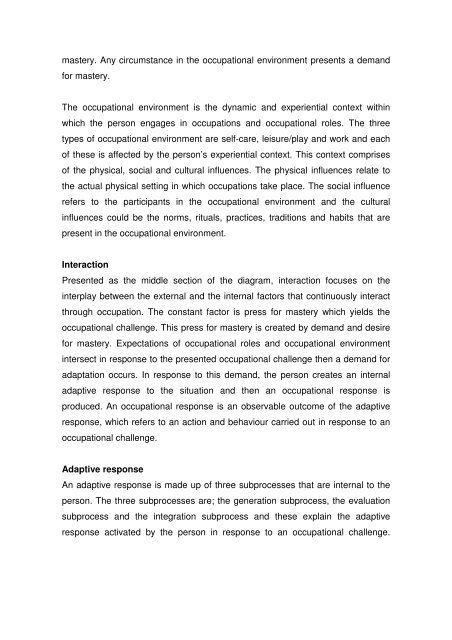Theory of Occupational Adaptation.pdf - Vula
Theory of Occupational Adaptation.pdf - Vula
Theory of Occupational Adaptation.pdf - Vula
Create successful ePaper yourself
Turn your PDF publications into a flip-book with our unique Google optimized e-Paper software.
mastery. Any circumstance in the occupational environment presents a demandfor mastery.The occupational environment is the dynamic and experiential context withinwhich the person engages in occupations and occupational roles. The threetypes <strong>of</strong> occupational environment are self-care, leisure/play and work and each<strong>of</strong> these is affected by the person’s experiential context. This context comprises<strong>of</strong> the physical, social and cultural influences. The physical influences relate tothe actual physical setting in which occupations take place. The social influencerefers to the participants in the occupational environment and the culturalinfluences could be the norms, rituals, practices, traditions and habits that arepresent in the occupational environment.InteractionPresented as the middle section <strong>of</strong> the diagram, interaction focuses on theinterplay between the external and the internal factors that continuously interactthrough occupation. The constant factor is press for mastery which yields theoccupational challenge. This press for mastery is created by demand and desirefor mastery. Expectations <strong>of</strong> occupational roles and occupational environmentintersect in response to the presented occupational challenge then a demand foradaptation occurs. In response to this demand, the person creates an internaladaptive response to the situation and then an occupational response isproduced. An occupational response is an observable outcome <strong>of</strong> the adaptiveresponse, which refers to an action and behaviour carried out in response to anoccupational challenge.Adaptive responseAn adaptive response is made up <strong>of</strong> three subprocesses that are internal to theperson. The three subprocesses are; the generation subprocess, the evaluationsubprocess and the integration subprocess and these explain the adaptiveresponse activated by the person in response to an occupational challenge.
















